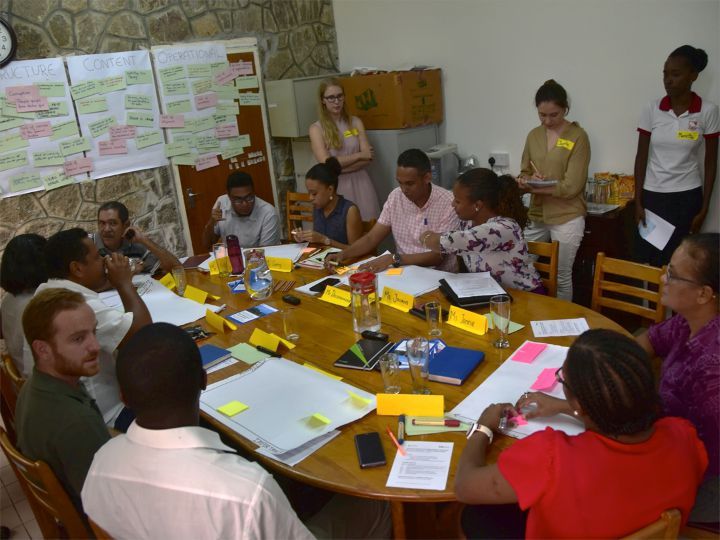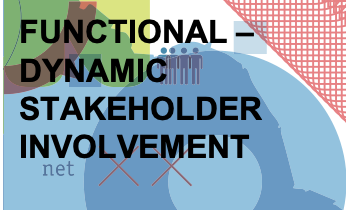Functional-dynamic stakeholder involvement
This approach helps specify the functional (related to the goal of the respective project step) as well as dynamic (related to the type of participation in the respective project step) involvement of stakeholders.
Krütli P 2021. Functional-dynamic stakeholder involvement. td-net toolbox (18). Swiss Academies of Arts and Sciences: td-net toolbox for co-producing knowledge. www.transdisciplinarity.ch/toolbox. doi.org/10.5281/zenodo.4627081
| What is a functional-dynamic approach? | The functional-dynamic approach specifies which stakeholders are to be involved in a td project and why, when, regarding what aspects and how. The stakeholder involvement finally is visualized in a diagram, listing the intensity of involvement (inform, consult, collaborate) of different stakeholders along a timeline of process steps. |
Why should it be applied? | The approach helps to define a procedure of how to involve stakeholders in the research process in a meaningful way and thereby supports the research teams’ organisation, the communication towards stakeholders as well as the management of expectations between stakeholders and the research team. The functional-dynamic diagram helps to define and illustrate at which points in the research process co-production is scheduled. |
When should it be applied? | Ideally early in the research process; during the planning phase when the research steps and the sequencing of these are further specified – if possible, together with the target stakeholders (co-design). |

| How does it work? | To specify stakeholder involvement, the research team answers the following questions for each envisaged research step. A. Who to involve? Which stakeholder(s) need(s) to be part of the project or a certain project step? ⇒ This question strongly depends on the Why question (see question B.), and the issue/content of the respective project step. B. Why to involve them? What is the rationale of the involvement? ⇒ According to Fiorino (1990) the rationale of involvement can be substantive because we need the stakeholders’ expertise/knowledge; it can be instrumental because the involvement helps us to achieve more legitimized solutions/decisions; or it can be normative because we want to involve those who are affected by our solutions/decisions. This is not an exhaustive list of rationales. There might be other reasons why to involve a stakeholder in the research process. C. When to involve them? At what stage of the project do we need to involve a particular stakeholder? ⇒ This strongly depends on what is at stake and also on the rationale of involvement (see question B.). Some stakeholders may be involved over the entire period of the project for instrumental reasons as they may help to implement innovations/research findings at a later stage, while in other cases we need to involve a particular stakeholder during a particular project step only. D. What aspects are stakeholders’ participation related to? ⇒ This question is related to the topic to be addressed/solved in a particular project step and it specifies also the Why question, e.g. the type of knowledge that is needed. E. How is participation carried out? ⇒ This question asks how we organize the stakeholder involvement (e.g., by workshops, focus groups, participatory mapping, field visits, public events etc.). While these questions may be discussed in a core team (from science and practice), it is prerequisite that the team considers what it has already learnt about the stakeholders’ expectations, interests, needs and justifications (see ‘What do I need to prepare?’ below). Based on the answer to these questions, the research team draws a curve for each stakeholder into a diagram (see picture) that depicts the stakeholder’s involvement: The x-axis depicts the involvement over time. For each process steps a point in time is listed.
It should be noted that different stakeholders may be involved in parallel (at different level of intensity) at a certain point in time/research step and that the intensity of involvement of stakeholders may vary over time. |
How are thought styles bridged? | The approach helps to clarify the project team’s and the stakeholders’ perspectives on engagement prior to involvement, and thereby prevents frustration (on either side) and assures that stakeholders expectations are discussed. By specifying in which research steps the research team collaborates with which stakeholders, spaces for co-production are created which allow for bridging different thought styles. |
| What’s the output/outcome? | The overall outcome is an increased satisfaction of the involved parties due to a well-functioning transdisciplinary research process that meets the interests/needs of both the scientists as well as the stakeholders. The approach’s immediate output is a diagram which depicts for each stakeholder the level of involvement on the y-axis (inform, consult, collaborate) in various research steps on the x-axis. Furthermore, there is a documentation of why (substantive, instrumental, normative rationale), and for what aspects of the project, the respective stakeholders will be involved. These outputs support a clarification of expectations for both, the research team and the stakeholders. |
| Who participates in what role? | The approach is here presented as a tool to get a research team organized. To assure congruency, stakeholder expectations should be addressed and clarified (see next question on preparation) before the functional-dynamic diagram is fully specified. The approach may be modified so that a heterogenous groups of researchers and stakeholders from practice (i.e., from the private and/or public sectors and/or the civil society) specify the functional-dynamic diagram together. This may be time consuming, especially for the stakeholders as they would have to go into the details of the whole research process. It may be more suitable to do a first draft of the diagram in the research team and then to validate it together with the key stakeholders. |
| What do I need to prepare? | In general, a good overview on the project and the succeeding steps of the project is prerequisite. To assure congruency between the functional-dynamic diagram drawn by the research team and the expectations of the stakeholders, the questions formulated in the previous section should already be kept in mind when a preliminary screening amongst potential stakeholders is done (see Krütli et al., 2010). To draw the functional-dynamic diagram and to ‘screen’ the potential stakeholders may be organized in an iterative process. This screening also includes further questions such as: How do the stakeholders perceive their role and mandate in the project? Do they ask for compensation for time spent, travelling, etc.? Do they ask for some decision-making power on particular aspects of the project? Are agreements needed on how involvement is formalized (e.g. through a MoU, contract)? Are there deliverables stakeholders are particularly interested in? To document the justification for involvement of the different stakeholders, you may prepare a template that you can distribute amongst your research team. |
| When not to use the method? | When the research process is already advanced and there is no room for adjustment in the way stakeholders are to be involved. |


